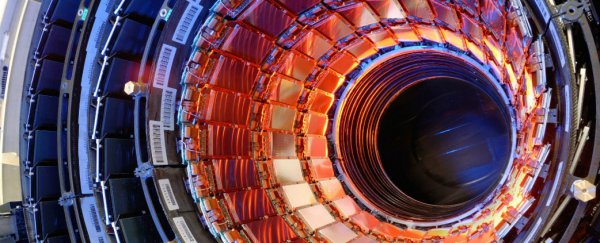Physicists at CERN have managed to create quark-gluon plasma - the particle 'soup' thought to have existed in the earliest moments following the Big Bang - using fewer particles than they ever thought possible. Nicknamed the 'littlest liquid', this incredibly hot and dense primordial goo can help us to understand how matter behaved and evolved mere microseconds after the birth of the Universe.
"While we believe the state of the Universe about a microsecond after the Big Bang consisted of a quark-gluon plasma, there is still much that we don't fully understand about the properties of this plasma," said one of the researchers, Quan Wang of the University of Kansas.
About 10-12 seconds after the Big Bang, scientists think that the Universe was made up of quark-gluon plasma, which they classify as an "almost-perfect liquid", because it has almost zero friction. Producing temperatures of between 4 trillion and 6 trillion degrees Celsius - about 100,000 times hotter than the centre of the Sun - this matter is the hottest thing ever created on Earth.
Quark-gluon plasma was first produced in the LHC back in 2012, but now researchers have been able to use fewer particles than thought possible to break down protons and neutrons into their smaller parts, called quarks and gluons. Each proton and neutron gives up three quarks each, and this will release the gluons - a massless form of matter that holds the quarks together with the help of a phenomenon known as Strong Force.
Thanks to this force, which is also called the colour force, under normal circumstances you couldn't pull protons and neutrons apart if you tried. This is because the amount of energy you'd need to do it would end producing brand new quarks (and their counterparts, antiquarks), which would take the place of the quarks you just 'freed'. This is known as quark confinement.
"Basically, you can't see an isolated quark because the colour force does not let them go, and the energy required to separate them produces quark-antiquark pairs long before they are far enough apart to observe separately," the Georgia State University website explains.
But the closer you squeeze these quarks and gluons together, the weaker this force becomes. Smash your particles together at incredibly high energy levels - such as what's created inside the LHC - and you'll end up with a dense 'soup' of individual ingredients rather than a collection of larger atoms.
"The implication is that the quarks in close confinement are completely free to move about," says Georgia State. "Part of the nature of quark confinement is that the further you try to force the quarks apart, the greater the force of containment."
The team from the Compact Muon Solenoid (CMS) Collaboration at CERN's Large Hadron Collider (LHC) managed to tear the protons and neutrons apart to form a quark-gluon plasma by smashing protons into lead nuclei at the speed of light inside the CMS detector.
"These tiny droplets of quark-gluon plasma were at first an intriguing surprise," one of the team, Berndt Mueller from the Brookhaven National Laboratory in the US, said in a statement. "Physicists initially thought that only the nuclei of large atoms such as gold would have enough matter and energy to free the quark and gluon building blocks that make up protons and neutrons."
"Before the CMS experimental results, it had been thought the medium created in a proton on lead collisions would be too small to create quark-gluon plasma," Wang added.
So what can we learn from this? Being able to recreate the first moments following the Big Bang using fewer materials than we thought possible means physicists will be able to more effectively study and understand how matter behaved during this time - often referred to as the Quark Epoch. How the basic forces that govern our Universe, such as gravity, came to be is also something researchers will be pursuing when they study quark-gluon plasma.
The results have been published in Physical Review Letters.
